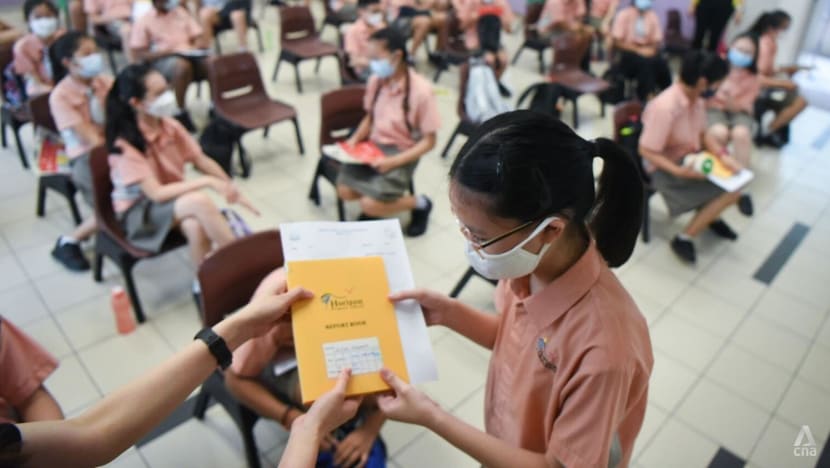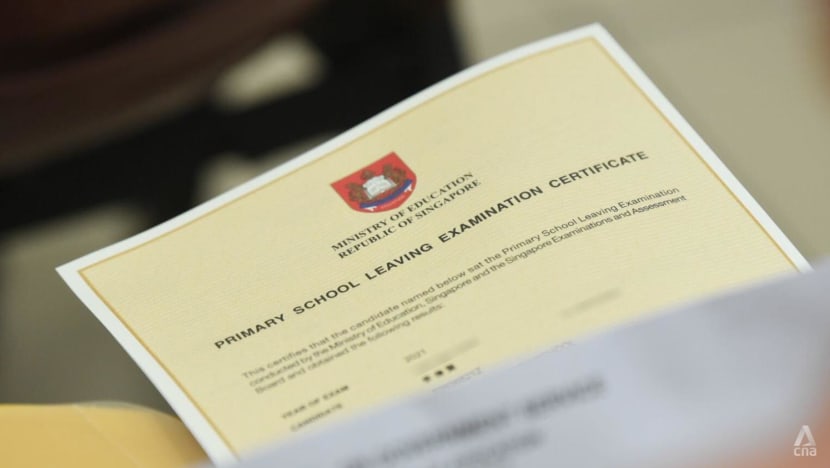Commentary: After PSLE, the big headache is choosing a secondary school
With the PSLE results now out, fretting begins on what secondary school to choose, says Adrian Tan.

Primary School Leaving Examination (PSLE) results are released at Horizon Primary School on Nov 24, 2021. (Photo: Gaya Chandramohan)
SINGAPORE: When the final paper for 2021’s Primary School Leaving Examination (PSLE) was done and dusted, all 12-year-olds in Singapore and their parents did a little dance of joy.
I was close to tears of joy after my son completed his. No more enrichment class expenses, no more chauffeuring to-and-fro his Chinese tutor and no more incessant reminders to get off his games and get on with his revision.
2021's batch was the first group to go through a new aggregate system replacing the T-score in place all these years.
The intention was to move away from chasing every single mark and students are now marked based purely on individual ability, instead of a bell curve.
But a new system brings uncertainties over where the cards will fall and this has some parents worried, especially those whose children are weak in one subject and unlikely to get a good band for it.
So, the fretting begins on what secondary school to choose once results are in.
STRATEGY OF AFFILIATION
One common strategy for most parents begins when they choose a primary school for their children. We picked one with a secondary school affiliation because entry requirements are lower compared to a child trying to get into the same secondary school without affiliation.
For example, St Patrick’s School had an indicative cut-off point of 10 to 14 for non-affiliated primary school graduates to get into the Express programme. A student from an affiliated primary school (say St Stephen’s School) would only require 12 to 20.
There are about 27 affiliated secondary schools in Singapore so parents with children in this track will pray their kids make the cut-off points.

There is also the Direct School Admission (DSA) route which allow students to get “early entry” into a secondary school, even before they sit for the PSLE.
Students apply based on their talent in sports, Co-Curricular Activities (CCAs) and specific academic areas, go for tests or auditions and are offered spots if they qualify.
A friend of mine has a daughter who is talented in synchronised swimming, and she got two offers.
In 2021, there was an increase in the number of DSA applications and parents interviewed by the media said they would rather “chope” a place for their children instead of waiting for results and having to scramble for a school they are not sure about.
For those without an affiliation to rely on and are not using the DSA route, it is time for some strategising.
SCORING A SPOT IN SCHOOL OF CHOICE
Students are given seven days from the release of PSLE results to shortlist six secondary schools in preferential order.
To give everyone a better idea of how to choose, the Ministry of Education (MOE) in 2021 released the entry and cut-off points for all secondary schools in April based on simulated scores modelled on the previous year's PSLE scores.
For a school like Nanyang Girls’ High School, the projected Achievement Level (AL) was between 4 to 7 (non-affiliated), based on the new T-score system.
That means scoring at least 90 per cent for each of the four subjects. Obviously, the better the overall scores, the better the chance to enter the school of choice.
In that sense, how students are funnelled hasn’t changed. Those who do well, get their pick and those in the middle must think more carefully.
BEING REALISTIC ABOUT OPTIONS
MOE has said the sequence of choices is critical.
Assuming all things being equal, the school will give the spots to students who selected them as their first choice (and qualify).
This is where it can get challenging for parents who wish for their children to go to a “good school”. In a way, they are working blind.
Some of my friends tell me some parents call the school and inundate the administrators with questions of what their chances are. This is a pointless exercise because the system must wait for all the information to be sorted before anyone knows anything.
The best thing parents can do is to be realistic and work on how the child did during their prelim exams.
But heed some caution. Just as adults don’t want to be stuck in an unsuitable company, our children shouldn’t be forced into a school – after all, they are the ones who must go through the next four years while parents watch from the sidelines.
Yet it is not uncommon to hear of parents wanting very desperately to pick a “good school" despite the child’s score being out of the suggested range. This idea of “let’s just try for first choice” isn’t prudent.
I know of friends who tried and then failed – ignoring the fact that mathematically speaking, the sorting will already push your child out. Sticking to a score and choice within reasonable expectations works better.

LET YOUR CHILDREN IN ON THE CONVERSATION
My advice is to involve your kids in choosing a secondary school. Our children are no longer the same people we hovered over during their Primary 1 recess. At their age, they are far more aware of who they are and what they want.
Look too at their personalities and their strengths.
MOE’s Education and Career Guidance unit came up with a guidebook with checklists on how parents can set up conversations with their kids around this topic.
Even if the child might be completely clueless on what they want in a secondary school, asking questions such as three positive words that describe them, the things they are most proud of and the types of activities they enjoy both in and out of school could provide a direction.
SkillsFuture even has a Career Quest microsite showcasing a game helping children discover their career interests and values.
Schools should be viewed holistically, based on the environment, their niche CCAs, culture, and style of learning.
But despite our best effort, all the information we get are still secondary sources. You cannot completely know if or how your kid will benefit from a school until they start their secondary school education.
A friend’s daughter joined a well-known secondary school touting creativity as a core value. But she soon found out that the school was stricter than they let on and felt stifled – so everyone’s experience can be different too.
Finally, don’t forget the distance between the school and home. Time spent on long commutes can be better spent on other more productive stuff.
FINAL DESTINATION MAY NOT BE IDEAL
Wherever your child is placed – whether in a top school of your choice, or a little-known neighbourhood school just two stops away from your HDB flat – what matters is how you support them in the next leg of their journey.
As a student, my cut-off points were not enough to get into the Express Stream for my first-choice secondary school. So I went to my second-choice school but struggled there too, having to repeat a year in Secondary 3.
It was a tough time but looking back at my journey, did the secondary school really decide the career path I would take or who I eventually became?
Of course not.
It really isn’t about the school but the student’s individual’s ability to make the best of the deck of cards he or she has been dealt with.
For wherever they are placed, they will learn about the world, about themselves, friendships and the most important lesson of all – that life is what you make of it.
Adrian Tan is the Future of Work Strategist at the Institute for Human Resource Professionals (IHRP) which aims to professionalise and strengthen the HR practice in Singapore and a father of four.



















